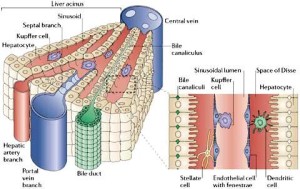Blood enters into the liver lobules via the hepatic artery, which then forms hepatic sinusoids that drain into the central vein in the centrilobular region of the liver (also called zone 3). The portal vein is an additional source of blood, bringing nutrient- and antigen-rich blood from the gastrointestinal system to the liver. This blood supply mingles with that of the hepatic artery in the sinusoids. Kupffer cells, which are phagocytic cells, are found within or below the fenestrated sinusoidal endothelium (pictured here within the sinusoids) and extend their processes into the sinusoids. These cells serve important filtering function, removing and processing antigens that arrive from the gastrointestinal tract or systemic circulation. In the space of Disse (the space just below the endothelium), there are other stromal cells, including stellate cells and antigen-presenting dendritic cells. Hepatocytes form cords that are 2 cells thick. Biliary canaliculi are located between the two cords of cells on the contralateral side of the sinusoids. The canaliculi drain into the biliary tubules, which are also located in the portal area (called zone 1). Since the centrilobular region is furthest away from the arterial blood supply, cells in this region are the first to be damaged by hypoxic injury.
Reproduced with permission from “Aberrant homing of mucosal T cells and extra-intestinal manifestations of inflammatory bowel disease” by Adams and Eksteen 2006, Nature Reviews in Immunology, 6: 244-251.

